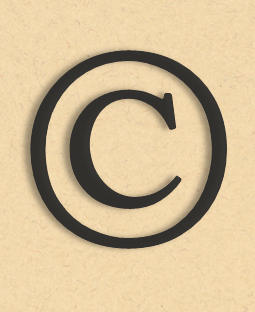Use Information Correctly
Copyright and Fair Use
Using copyrighted material
 The copyright symbol
The copyright symbolAs you learned earlier, you generally need to license copyrighted material in order to use it, which often costs money. The exception to this is a rule called fair use. Fair use means you can use copyrighted material without a license only for certain purposes. These include:
- Commentary
- Criticism
- Reporting
- Research
- Teaching
You can't just grab a copyrighted photo and use it on your blog because you think it's pretty. However, it probably would be considered fair use if you included the photo in a blog post that commented on and analyzed the photographer's work.
Guidelines for fair use:
- A majority of the content you create must be your own.
To return to the example above, it's probably fair use to include a few relevant photos to support your ideas in a blog post, presentation, or research paper. However, using these same photos in a project with only a few lines of commentary might not be fair use. As another example, let's imagine you found a useful tutorial you wanted to feature on your blog. Including one tip from the tutorial would be fair use. Simply republishing the entire tutorial would not be fair use, even if you linked to the original source. - Give credit to the copyright holder.
In order for something to be fair use, you must give full credit to the person who created it. This includes the creator's name, as well as other information that will help people find the original work or source. For example, if you adapt a recipe that was originally published on a cooking website, you should include a link to the original page. For more help citing your sources, review Avoiding Plagiarism. - Don't make money off of the copyrighted work.
In general, it's much easier to claim fair use when you're using the copyrighted material for noncommercial purposes. While posting images of your favorite TV shows and adding funny captions and commentary might be considered fair use, selling these images on T-shirts would not.
Misusing copyrighted material

The concept of fair use can be tricky, especially when it comes to creating work you don't intend to post or publish. For example, if you download a series of graphics from a designer's website and use them to create a PowerPoint template for you and your coworkers (without permission), you could argue that it was never meant for the public and that you didn't mean any harm.
In situations like this, it's important to put yourself in the copyright holder's shoes. It's true that he or she will probably never find out about the template. It's also a relatively minor violation because you're just using the graphics around the office.
But how would you feel if you were a graphic designer and learned that people were using your work (your livelihood) in a way you didn't intend? And you're not getting paid or credited for it!
In short, it's better to do what's right than to risk violating copyright and fair use laws. Even if you think what you're doing is not a big deal, the copyright holder may disagree. If someone requests that you remove his or her materials from your work, you should do so immediately. Otherwise, you can suffer serious consequences, including:
- Having your website shut down if your work is published online—like on a blog—after the copyright holder complains to your hosting service
- Getting sued by the copyright holder






